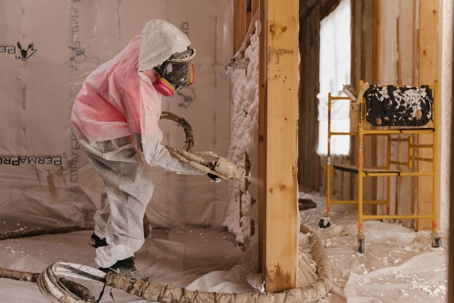If you're considering spray foam insulation, you may wonder, "How thick should spray foam insulation be to achieve optimal results?"
The answer depends on factors like:
- Foam type (open cell vs. closed cell),
- Application area, and
- Your goals and your home's specific needs.
Continue reading to discover how experts achieve the optimal spray foam thickness!
Open-Cell vs. Closed-Cell: What’s the Ideal Spray Foam Thickness?
The thickness depends on the type of foam being installed and the location of the installation.
Open-Cell Spray Foam Thickness
The open-cell spray foam insulation thickness recommended by experts is:
- Roof deck: 5.5 inches
- Ceiling: 5.5 inches
- Walls: 3.5 inches
Closed-Cell Spray Foam Thickness
The closed-cell spray foam insulation thickness recommended by experts is:
- Roof deck: 3 inches
- Ceiling: 3 inches
- Walls: 2 inches
As you can see, the ideal thickness for your spray foam varies depending on several factors.
That's why it's essential to rely on veteran insulation experts. At iFOAM, our spray foam contractors have extensive training in measuring foam thickness accurately. Listening to experienced pros will help you achieve the best insulation results for your abode.
Consider Your Spray Foam Goals
Maximizing the benefits of spray foam insulation demands meticulous planning tailored to a building’s specific needs.
Choosing the standard thickness of spray foam insulation may seem adequate when creating an air seal and improving the thermal resistance of a home. However, it might require more foam if you want to soundproof a room or lower their utility bills as much as possible.
In most cases, several inches of standard foam will work, depending on the types of spray foam used: open-cell or closed-cell foam. Still, the required thickness of the spray foam depends on the application location, R-value, and the specific outcomes homeowners aim to achieve.
Moisture Control
Insulation shields against harsh temperatures, often forming an air-seal barrier. Beyond temperature control, it also safeguards ceilings, floors, and walls against dampness. Spray foam insulation controls moisture around the house, which is crucial when facing extreme weather or a damp climate.
Insulation protects a building from potential water damage and prevents mold growth. Professionally installed insulation will maintain a dry, healthy environment.
Energy Efficiency
For homeowners wondering why they have such high energy costs, it is probably due to defective home insulation.
Improperly installed coverings have tiny gaps that let outside air sneak into the house, resulting in the HVAC system, air conditioner, or heater going into overdrive to balance the temperature.
Having perfectly installed insulation will save residents from exorbitant bills.
Improved Indoor Air Quality
The right insulation thickness helps reduce seasonal allergies. By creating an impenetrable air seal, homeowners will keep allergens from entering their living space.
The best way to achieve an allergen-free environment is to use spray foam insulation. It provides an extra layer of protection against potential allergy triggers. So, how thick does spray foam insulation need to be? Let’s find out.
Why Does the Right Spray Foam Thickness Matter?
Getting the spray foam insulation thickness right is crucial for a successful and long-lasting project.
Applying too little foam can lead to some serious consequences:
- Lower R-Value. Insufficient thickness results in a lower R-value. This means the insulation won't be as effective at preventing heat transfer. This translates to higher energy bills and less comfortable living conditions.
- Poor Air Sealing. Inadequate foam thickness can leave gaps and cracks, allowing air to leak in and out of your home. This can lead to drafts and increased energy costs.
- Moisture Issues. If the foam isn't thick enough, moisture can penetrate the insulation. Moisture can cause mold and mildew growth. Mold can damage your home's structure and pose health risks.
Think of it this way: Imagine trying to keep warm in a thin jacket during a blizzard. You'd be shivering and uncomfortable, right? The same principle applies to your home. Proper spray foam thickness keeps your home cozy and your energy bills low.
How We Get Spray Foam Thickness Right
Achieving optimal insulation performance depends on applying the correct spray foam thickness.
That's why we take a meticulous approach to every project:
- Adhering to Manufacturer Guidelines. We follow the manufacturer's instructions for the type of spray foam insulation we use. This ensures we achieve the desired R-value and optimal performance.
- Years of Experience. Our installers have years of experience installing spray foam insulation in across the country. We'll determine the appropriate thickness for your specific needs.
- Quality Control Measures. We implement rigorous quality control measures throughout the installation process.
Enjoy a Cozy Home with iFoam Insulation!
How thick does spray foam insulation need to be? Now that you know how thick spray foam should be, you can avoid over-spraying and enjoy a relaxing home by leaving it to the professionals. Engage a top-notch insulation contractor to ensure your home remains comfy throughout the year. Call iFoam at (855) 935-4723 to discuss a professional installation today!
Frequently Asked Questions
Can spray foam be too thick?
Yes, spray foam can be too thick. Applying more foam than recommended doesn’t increase your home’s R-value or insulation effectiveness.
Instead, it may lead to unnecessary costs without additional benefits. The key to effective insulation is achieving a proper air seal. Sticking to the recommended thickness ensures optimal performance, cost efficiency, and long-term comfort.
Will I need multiple applications of spray foam insulation?
No. In most cases, a single application at the appropriate thickness can provide both effective air sealing and sufficient thermal resistance.

